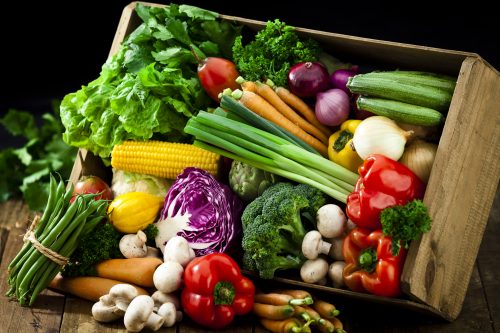
By now, most people have received the five-plus-a-day message loud and clear, but many of us are still falling short. To clear any confusion (how many ‘portions’ are in a smoothie? Do potatoes count?), here is the HFG guide to five-plus-a-day.
Eat at least five portions of vegetables and fruit each day
…and you will be a step closer to improving your health and controlling your weight.
It sounds like a simple enough message, doesn’t it? But the truth is, when it comes to five-plus-a-day, many of us remain baffled about what really counts. Are potatoes in or out? Are frozen vegetables included? And do we need to eat separate portions of vegetables or do they still count if they are part of a dish like stew or lasagne? With so many unanswered questions, it’s not surprising that most of us still fail to get enough veggies and fruit.
A 2008/09 Adult Nutrition Survey found that around 40 per cent of men and 28 per cent of women are not eating the recommended three or more servings of vegetables each day, and 45 per cent of men and 34 per cent of women fell short of eating the recommended two or more servings of fruit each day. And as far as veggies go, it’s an even gloomier picture for children and young people, with around 60 per cent not eating three or more serves each day.
Encouragingly, many experts believe that getting to grips with what five-plus-a-day actually means — and seeing how easy it is to achieve — can help motivate us so that we quickly reach that daily figure. Then it won’t be long before we start noticing the benefits to our health.
So what counts?
All varieties of vegetables and fruit count towards your five-plus-a-day, whether fresh, frozen, canned or dried.
They don’t have to be cooked separately or eaten separately — vegetables added to stir-fries, stews, soups, casseroles, pasta or rice dishes and sauces are all included. You can also count:
Pure fruit and vegetable juices
With fruit juice, we count one small glass as one portion, but drinking more than this doesn’t increase your total because, unlike whole fruits, pure juices are low in fibre. We recommend juice as an additional serve rather than replacing a piece of fruit.
Smoothies
Each one can provide up to two portions, but this is the maximum, even if you drink a lot. To count as two portions, a smoothie must contain around 80g whole fruit and/or vegetables, plus 125ml pure juice, eg. 80g blackberries and 125ml pure apple juice. Alternatively, it must contain two 80g portions of different fruit and/or vegetables, eg. 80g banana and 80g berries.
Veggies and fruit in ready-made foods
Vegetables and fruit in ready-made meals, soups, sauces, puddings and takeaways count, but they may also come packaged with large amounts of fat, sugar and/or salt. Check the nutrition information to see whether eating the product is really worth it to get one of your five-plus-a-day.
What do we limit?
Potatoes and kumara/sweet potato
These starchy vegetables tend to be served as a carbohydrate in the same way as bread, pasta and rice, so when analysing the vegetable serves in our recipes at HFG we count them as a maximum of one veggie serve. While they are healthy veggies, it’s important to get a variety of other low-energy vegetables with different nutrients.
Legumes and pulses
Such as lentils, kidney beans, baked beans and chickpeas. We count these as one serve regardless of whether you eat more, because they contain different nutrients from fruit and vegetables. There’s no reason to limit our actual intake: as well as being high in fibre these contribute protein to the diet and have been shown to enhance health.
Avocado
When counting our veggie serves we count one-quarter of an avocado as a serve (even though it’s arguably a fruit). While it’s full of fibre and nutrients, we limit avocado to one serve, as unlike other vegetables and fruit, avocado is very high in fat and kilojoules — worth remembering if you are watching your weight.
Do I need to eat a variety?
Yes! Different types of vegetables and fruit contain various combinations of fibre, vitamins, minerals and phytonutrients, so to get the most benefit it’s best to mix them up. An easy way to check you are doing this is to eat five or more different-coloured vegetables and fruit every day.
Why five serves?
The five-plus-a-day message is based on a report from the World Health Organisation (WHO) that came out in 1990 after looking at the amount of vegetables and fruit eaten in different regions. High intakes of vegetables and fruit, such as in southern Italy and Greece, were linked to low rates of coronary heart disease and of some cancers. An updated report from the WHO in 2003 confirmed these findings and continues to recommend a minimum of 400g of vegetables and fruit each day to prevent chronic diseases such as heart disease, cancer, diabetes and obesity. More is even better.
To make it easier for us, this 400g target can be translated into five separate servings of around 80g. The exception is dried or juiced fruit — one serve of dried fruit is about 25-30g and one serve of pure fruit or vegetable juice is about half a cup or 125ml.
Nobody wants to be weighing out their vegetables and fruit at every meal so check our guide below to see at a glance the amount that counts as one of an adult’s five-plus-a-day.
How much for children?
For children, a helpful guide to portion size is the equivalent of the amount that would fit into the palm of the child’s hand. As a rough guide, 50-60g might be a suitable portion size for children and once they reach about 12 years old, go with the 80g portion.
Why are vegetables and fruit so important?
- They are rich in fibre, important for healthy digestion and to help prevent conditions like constipation and bowel cancer.
- They contain a variety of vitamins and minerals, such as folate, beta-carotene (which the body uses to make vitamin A), potassium and vitamin C.
- They are packed with a variety of antioxidants that help stop free radicals attacking our cells, causing damage that can lead to health problems such as heart disease, strokes and cancer.
- They’re usually low in fat and kilojoules but they fill us up, so they can help us control our weight.
Your guide to 1 serve
This is a rough guide: obviously, the size of vegetables and fruits vary widely and some produce contain lots of water while others have less. The main thing is to include a range of different coloured vegetables and fruits in your diet every day. If you know you probably don’t eat enough, focus on where you can add just one more serve to your day and take it from there. And for those of us who do get five-a-day already, there are still benefits of adding a ‘plus’ to that!
1 serve of vegetables
Is about:
- 1/2 cup chopped vegetables
- 1 cup raw leafy vegetables (not too loosely packed) or sprouts
- 1/2 cup cooked dried beans
Or you could use:
- 1 tomato
- 1 carrot
- 1 courgette
- 1 capsicum
- 1 leek
- 1 onion
- 1 parsnip
- 1 medium potato
- 1 small kumara
- 4 radishes
- 4 shallots
- 5 asparagus spears
- 5 Brussels sprouts
- 1/2 corn cob
- 1/4 cup tomato paste or purée
- 1/4 avocado
Or if using by weight:
- About 80g
How many serves?
- Cauliflower: around 12 serves in an average 1kg head
- Cabbage: around 9 serves in an average 900g head
- Broccoli: around 6 serves in an average 500g head
- Eggplant: around 4 1/2 serves in an average 400g eggplant
1 serve of fresh fruit
Is about:
- 1 apple
- 1 orange
- 1 banana
- 5cm slice melon or mango
- 1/2 grapefruit
- 1 large slice pineapple
- 1/3 cup fruit salad
- 1/2 cup grapes
- 1/2 cup blueberries, blackberries, boysenberries, raspberries or strawberries
- 7 cherry tomatoes
- 1/4 cup tomato purée
- 14 cherries
- 1 nectarine
- 1 large mandarin
- 1 large plum
- 1 kiwifruit
- 2 figs
- 3 apricots
- 6 passionfruit
- 1 pear
1 serve of dried fruit
Is about:
- 3 level tablespoons sultanas, currants or dried cranberries
- 4 level tablespoons raisins
- 6 apricot halves
- 4 pieces sun-dried tomato
- 2 figs
- 4 apple rings
- 3 prunes
1 serve of canned fruit
Is about:
- 2 pear halves
- 2 peach halves
- 2 pineapple rings
- 6 apricot halves
- 12 pineapple chunks
Or if using by weight:
- About 80g for fresh, frozen or canned fruit
- 25-30g for dried fruit
3 + 2 = 5
Remember the starting point for your five-plus-a-day is three vegetable serves and two fruit serves.
Fight disease
Eat 400g or more of vegetables and fruit each day to help prevent diseases.
Visual guide to serving sizes
www.healthyfood.com










